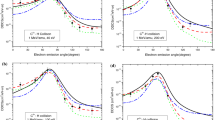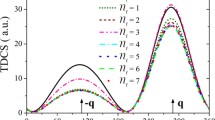Abstract.
Enhanced stopping of swift hydrogen diclusters has been analysed theoretically. The target has been modeled as a gas of harmonic-oscillator atoms of variable density. This model predicts a proximity effect, i.e., enhanced stopping at high beam energy, and an oscillatory behavior at low energy. Both features get less pronounced with increasing target density due to increased screening of the ion-target interaction by polarization of the medium. Static screening by electrons accompanying the cluster likewise reduces the proximity effect. The Barkas-Andersen correction has been estimated in the \(Z_1^3\) limit. Our findings are in contrast with measurements on SiO2 [S.M. Shubeita et al., Phys. Rev. B 77, 115327 (2008)] which showed a pronounced step in the energy dependence of the proximity effect.
Similar content being viewed by others
References
N.R. Arista, Nucl. Instr. Methods B 164-165, 108 (2000)
R.I. Ewing, IRE Trans. Nucl. Sci. 9, 207 (1962)
W. Brandt, A. Ratkowski, R.H. Ritchie, Phys. Rev. Lett. 33, 1325 (1974)
N.R. Arista, Phys. Rev. B 18, 1 (1978)
J. Lindhard, Mat. Fys. Medd. Dan. Vid. Selsk. 8, 1 (1954)
J. Steinbeck, K. Dettmann, J. Phys. C 11, 2907 (1978)
G. Basbas, R.H. Ritchie, Phys. Rev. A 25, 1943 (1982)
E. Ray, R. Kirsch, H.H. Mikkelsen, J.C. Poizat, J. Remillieux, Nucl. Instr. Methods B 69, 133 (1992)
J. Jensen, H.H. Mikkelsen, Nucl. Instr. Methods B 115, 39 (1996)
J. Jensen, P. Sigmund, Phys. Rev. A 61, 032903 (2000)
J.D. Jackson, Classical electrodynamics (John Wiley & Sons, New York, 1975)
S.M. Shubeita, M.A. Sortica, P.L. Grande, J.F. Dias, N.R. Arista, Phys. Rev. B 77, 115327 (2008)
P. Sigmund, U. Haagerup, Phys. Rev. A 34, 892 (1986)
A. Belkacem, P. Sigmund, Nucl. Instr. Methods B 48, 29 (1990)
S.M. Shubeita, R.C. Fadanelli, J.F. Dias, P.L. Grande, C.D. Denton, I. Abril, R. Garcia-Molina, N.R. Arista, Phys. Rev. B 80, (2009)
H.H. Mikkelsen, P. Sigmund, Phys. Rev. A 40, 101 (1989)
H.H. Mikkelsen, E.H. Mortensen, Nucl. Instr. Methods B 48, 39 (1990)
N.R. Arista, V.H. Ponce, J. Phys. C 8, L001 (1975)
W. Brandt, R.H. Ritchie, Nucl. Instrum. Methods 132, 43 (1976)
W. Brandt, M. Kitagawa, Phys. Rev. B 25, 5631 (1982)
M. Abramowitz, I.A. Stegun, Handbook of mathematical functions (Dover, New York, 1964)
J. Lindhard, A.H. Sørensen, Phys. Rev. A 53, 2443 (1996)
P. Sigmund, Particle penetration and radiation effects, bd. 151 af Springer Series in Solid-State Sciences (Springer, Berlin, 2006)
J.C. Ashley, R.H. Ritchie, W. Brandt, Phys. Rev. B 5, 2393 (1972)
J. Lindhard, Nucl. Instrum. Methods 132, 1 (1976)
P. Sigmund, A. Schinner, Phys. Scr. T 92, 222 (2001)
J. Oddershede, J.R. Sabin, P. Sigmund, Phys. Rev. Lett. 51, 1332 (1983)
J. Lindhard, A. Winther, Mat. Fys. Medd. Dan. Vid. Selsk. 34, 1 (1964)
P. Sigmund, Nucl. Instr. Methods B 67, 11 (1992)
C. Tarrio, S.E. Schnatterly, J. Opt. Soc. Am. B 10, 952 (1993)
ICRU, Stopping of ions heavier than helium, ICRU Report (Oxford University Press, Oxford, 2005), Vol. 73
P. Sigmund, A. Schinner, Nucl. Instr. Methods B 195, 64 (2002)
I. Abril, M. Behar, R. Garcia-Molina, R.C. Fadanelli, L.C.C.M. Nagamine, P.L. Grande, L. Schunemann, C.D. Denton, N.R. Arista, E.B. Saitovitch, Eur. Phys. J. D 54, 65 (2009)
R.D. Mui\(\tilde{{\rm n}}\)o, A. Salin, Phys. Rev. B 62, 5207 (2000)
N.R. Arista, A.F. Lifschitz, Phys. Rev. A 59, 2719 (1999)
N. Bohr, Mat. Fys. Medd. Dan. Vid. Selsk. 18, 1 (1948)
P. Sigmund, A. Schinner, Eur. Phys. J. D 12, 425 (2000)
Author information
Authors and Affiliations
Corresponding author
Rights and permissions
About this article
Cite this article
Sigmund, P., Schinner, A. Stopping of swift hydrogen diclusters: oscillator model. Eur. Phys. J. D 61, 39–50 (2011). https://doi.org/10.1140/epjd/e2010-10144-9
Received:
Revised:
Published:
Issue Date:
DOI: https://doi.org/10.1140/epjd/e2010-10144-9




